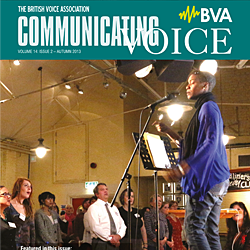About the Association
Van Lawrence Prize 2004
The interaction of sensory modalities in the learning and memorisation procedures of professional and student singers – (abstract)
Sue Anderson
Sue Anderson, 2004 BVA Van Lawrence Winner, read music at Oxford, where she completed an MA in Psychology for Musicians at Sheffield University. As a performer she gave her Wigmore Hall debut as a solo pianist but has since worked for many years as a singer performing at Covent Garden and Glyndebourne and giving concerts of contemporary music throughout Europe. She regularly runs courses for those who 'can't sing' and teaches singing, piano and practical musicianship.'Detailed discussions on how to memorise music tend not to be an integral part of the music lesson'. (Aiello & Williamon 2002).
Although confident memorisation can be a crucially important factor in building a career for both instrumentalists and singers, it is rarely taught systematically at any stage in a musician's life. It is far more usual for a student to be told to 'just go away and learn it!' Inevitably some do have memorisation problems, and they drop out or specialise in areas where it is not needed. Both my academic research and practical experience would indicate that it is perfectly possible to develop robust memorisation techniques, and yet they are rarely taught.
Ideas about the relative importance of the three modes of memory - aural, visual and kinaesthetic - were first put forward in piano methods published early last century by Matthay (1913, 1926) and Gieseking and Leimar (1932), and they both emphasised aural and visual modes being more reliable than kinaesthetic or finger memory for public performance. Most of the available research literature is about pianists, and it is only recently with the research of Ginsborg (2002) that there has any attempt to investigate the far more complex situation surrounding the strategies used by singers. But singers are expected to perform all but the most difficult contemporary music from memory, even at the very first grade examination.
Today's presentation investigates how professional singers prepare for confident memorised performance, and how their early singing and instrumental experiences affect their approach. It is principally based on semi-structured interviews with seven professional singers, analysed using IPA or Interpretative Phenomenological Analysis as described by Smith (1995). Open-ended questions on the subjects of early musical experiences and learning and memorisation methods allowed the participants to discuss items that they considered important. Similar questions in questionnaire form were answered by 50 singing students from the Royal College of Music and at Trinity.
Almost all children sing, unless told to be quiet! They mimic, copy, add their own words, and thoroughly enjoy nursery rhymes, adverts & signature tunes on television, and they gradually gain the ability to sing 'in tune'. The seven singers I interviewed were no exception! They all spoke of very strong early responses to music, singing and dancing to whatever sounds happened to be around them. One had apparently sung 'some Hindemith violin sonata aged three or four or something', in imitation of the sounds played by an older sister! Another started singing by imitating Cilla Black and Lulu. So the earliest mode of learning for most singers is emphatically aural.
When a child is thought to be 'musical', they are often encouraged to learn an instrument, and will almost always then be introduced to the world of notation, learnt visually.
‘Somehow reliance on the written fundamentally affects our willingness to trust in and develop our aural memory' (Odam, The Sounding Symbol 1996)
Research summarised by Smyth (1984) found that in Western cultures, evidence from the visual sense is believed and trusted even when it is at complete variance with evidence from other sensory sources. So the emphasis in the classical tradition on learning notation may well be at the expense of the development of aural memory and kinaesthetic awareness.
Several singers in my research described having a visual, almost photographic image of the music in their minds even as they are singing from memory... ‘I'll know I'll be at the top LH corner of the 3rd page, which I feel is a hindrance because I feel it's like - I'm almost sight-reading it even though I'm not using the music.'
In Ginsborg's research (2002), it was found that the best memorisers practised recall sooner and memorised earlier than others, effectively keeping the time spent relying on the visual image alone as short as possible.
The introduction of notation for instrumental studies didn't affect how some singers learnt vocal music at all; 'reading music was for piano lessons!' But for one singer, the insistence that she should not play the piano by ear or improvise, so that she would learn to read music, seriously affected her aural memory and musical confidence.
Lucy Green in 'How popular musicians learn' (2002) described an informal aurally-based approach to learning that contrasts sharply with the formal visually-based system of symbolic notation dominant in the classical tradition. But, aural and visual ways of learning can come with value judgements, and can be thought to represent conflicting rather than complementary ways of acquiring musical expertise. The singers' responses reflect this attitude; for example one confessed to learning the piano 'naughtily by ear, I'm afraid'. However, research findings now suggest that children taught by ear in the earliest stages may have certain advantages, of greater motivation and more enjoyment in playing (McPherson & Gabrielsson 2002).
Responses from the student questionnaires suggest that the age when notation is introduced may be very significant.
Results show that 'not confident sight-readers' began to read music on average 2½ years later than average or confident sight-readers. But that, 'not confident memorisers' began to read over 4 years earlier than the average or good memorisers.
I wasn't surprised by the first result, but found the second result very interesting. Perhaps very early learning of notation means that aural aspects of music are not fully established before being inseparably linked to the symbolic system.
The seven professional singers all described three fairly clear stages when learning new repertoire. Most would begin by listening just once to a recording of the piece, if possible, to get an overview of orchestration, harmony and structure, certainly not to copy the artist. However, the use of recordings by students as their principal means of learning new repertoire was criticised by several participants as 'just mimicking' and not really very healthy.
The second stage in the learning process was then at the piano; 'thumping out the notes', and 'plonking it out on the piano' are two phrases used to describe this activity. While working at the piano, the singer uses both visual and aural modalities, hearing and repeating their own melodic line, and also forming an aural memory of the harmonic structure.
The final stage usually involved working with a coach at some point, reinforcing aural recognition of cues, and 'learning within the harmonic soup' as one singer put it. The majority also used recordings, either CD's, or tapes made specifically for the purpose. One singer described recording a particularly complex contemporary score 'in order to save my voice' whilst memorising it. Another listened repeatedly to a recording made by her coach of 'the whole of her part and all the vocal cues that went with it.' So aural and visual modes continually interact and reinforce each other during the learning procedures of most professional singers.
In contrast to the directives from Matthay et al, the singers found a particular type of kinaesthetic or proprioceptive memory very desirable, an essential ingredient in the recipe for successful memorised performance. In response to the question 'Is there a difference between music being memorised and it being "in the voice"?' the answers were very emphatic.
Yes, it is different. Being 'in the voice' means to me to be really worked into the system vocally - muscularly and neurologically.
Another singer described performing Pierrot Lunaire from memory, 'I wouldn't want to do it any other way now, because that's just sort of in my body, you know it just feels right.' She added 'your voice will do it automatically' even if the mind had briefly blanked out. This gave her an additional layer of kinaesthetic security, enabling her to perform whole recitals of contemporary music from memory.
The view was frequently expressed that one of the problems associated with the 'sight-read-sing' culture prevalent in much of British musical life, was that music was learnt too quickly and that it was then not 'in the voice'. Describing students from this background, one teacher said that 'they wanted to be able to …do it straight away, and this idea of inculcating it, letting it grow into the vocal mechanism was foreign'. A singer with poor reading found that there were real advantages in learning slowly:
If you take the time to learn something then you start to develop a rapport with the notes and the physicality of the notes, …and feel it physically and know it in the breath and the body.
Although all three sensory modes contribute to the secure memorisation of a piece, the singers were adamant that visual and aural knowledge of the piece was not enough, it needed to be 'in the voice' as well.
The idea that memorisation is merely a matter of repetition; 'It's just doing it over and over again' was echoed by 64% of the musicians interviewed by Hallam (1997). But research has shown that simple repetition is not robust enough in itself to guarantee memorised concert performance. The 'Levels of Processing' model proposed by Craik & Lockhart, indicated that rich, elaborate, complex information is actually retained and retrieved more easily than simple, shallow fact. Multi-modal tags allow the material to have a flexibility of retrieval that can adapt to changing circumstances, a viewpoint that is supported by a growing body of recent research (Langer 1997, and Hallam 1997).
The rehearsal period for opera gives a chance to weave rich and elaborate visual, aural and kinaesthetic threads into the memorisation tapestry. The two singers least involved in opera displayed the greatest metacognition, or awareness of how they learn. They used many different approaches in their search for secure memorisation; drew 'very bad' pictures, spent a long time with a highlighter marking up the score and mentally rehearsing, they listened to recordings and they explored harmonic nuances at the piano.
But a final thought! One singer said that she sometimes had the music with her, 'as reference', but that she would then 'screw up!' Having the score nearby seemed to create a mentally ambiguous situation. The other just said 'it never occurred to me that my memory could fail me with singing', an amazing example of confident memorisation!
In conclusion, I will just point out some factors that I found surprising or interesting, but with the caveat that one should not generalise from a relatively small sample.
- All except one of the singers used recordings to some extent when learning new repertoire
- All grudgingly used the piano to support their learning from the score
- Concert and recital singers tended to show more metacognition than those specialising in opera
- All the singers stressed the importance of proprioceptive memory, describing this as music being 'in the voice' or 'in the body'
- It is possible that there is an optimum age-range for learning to read notation
- Prolonged use of the score, both in learning new repertoire, and by singing regularly in sight-read-sing situations, may inhibit the full development of aural and kinaesthetic awareness.
Singing teachers do not usually discuss 'how to learn' with their students. But the cultivation of a balanced use and interaction of all three sensory modalities in the learning and memorisation process may have considerable impact on vocal quality, on confident performance and ultimately may even be a factor in the success or failure of a singer's career.
References
Aiello, R. & Williamon, A. (2002) Memory In Parncutt & McPherson (eds.) The Science and Psychology of Music Performance. Oxford University Press. 167-182
Baddeley, A. (1997) Human Memory: Theory and Practice. Psychology Press. 118-124
Craik, F.I.M. & Lockhart, R.S. (1972) cited in Baddeley above.
Ginsborg, J. (2002) Classical singers' learning and memorising a new song: an observational study. Psychology of Music. 30: 58-101
Green, L. (2002) How Popular Musicians Learn. Ashgate
Hallam, S. (1997) The development of memorisation strategies in musicians: implications for education. British Journal of Music Education. 14: 87-97
Langer, E.J. (1997) The Power of Mindful Learning. Addison-Wesley Publishing
Matthay, T. (1913, 1926) and Gieseking, W & Leimar, K. (1932) cited in Aiello & Williamon above.
Odam, G. (1995) The Sounding Symbol. Nelson Thornes.
Smith, J.A., Harré, R. & Langenhove, L.V. (eds) (1995) Rethinking Methods in Psychology. Sage Publications.
Smyth, M. (1984) Perception in Action. In Smyth & Wing (eds.) The Psychology of Human Movement. Singular Publishing Group.

 Join us Now!
Join us Now! our newsletter
our newsletter free voice care leaflets & information – download here
free voice care leaflets & information – download here Help our work by donating while you shop
Help our work by donating while you shop